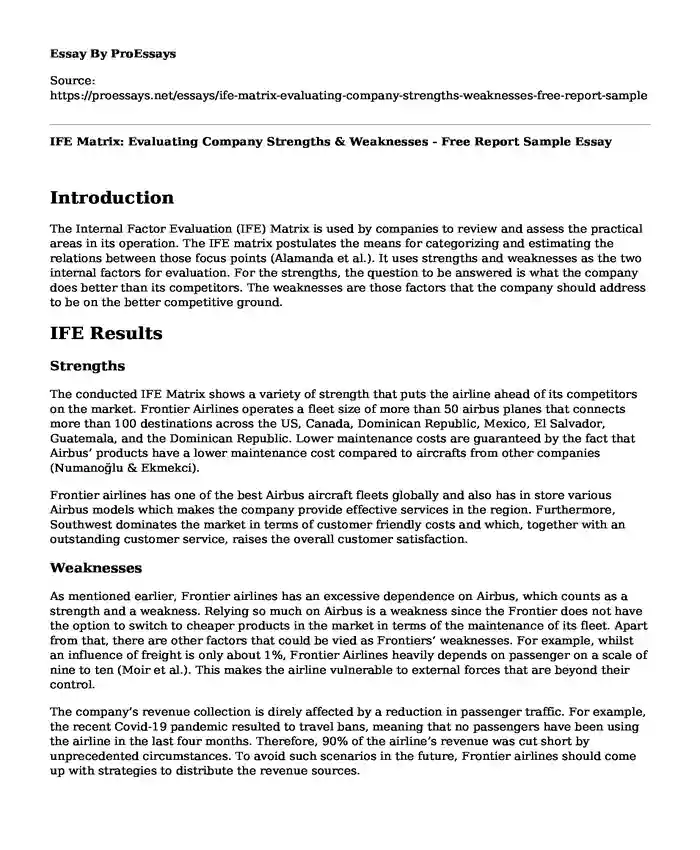Introduction
The Internal Factor Evaluation (IFE) Matrix is used by companies to review and assess the practical areas in its operation. The IFE matrix postulates the means for categorizing and estimating the relations between those focus points (Alamanda et al.). It uses strengths and weaknesses as the two internal factors for evaluation. For the strengths, the question to be answered is what the company does better than its competitors. The weaknesses are those factors that the company should address to be on the better competitive ground.
IFE Results
Strengths
The conducted IFE Matrix shows a variety of strength that puts the airline ahead of its competitors on the market. Frontier Airlines operates a fleet size of more than 50 airbus planes that connects more than 100 destinations across the US, Canada, Dominican Republic, Mexico, El Salvador, Guatemala, and the Dominican Republic. Lower maintenance costs are guaranteed by the fact that Airbus’ products have a lower maintenance cost compared to aircrafts from other companies (Numanoglu & Ekmekci).
Frontier airlines has one of the best Airbus aircraft fleets globally and also has in store various Airbus models which makes the company provide effective services in the region. Furthermore, Southwest dominates the market in terms of customer friendly costs and which, together with an outstanding customer service, raises the overall customer satisfaction.
Weaknesses
As mentioned earlier, Frontier airlines has an excessive dependence on Airbus, which counts as a strength and a weakness. Relying so much on Airbus is a weakness since the Frontier does not have the option to switch to cheaper products in the market in terms of the maintenance of its fleet. Apart from that, there are other factors that could be vied as Frontiers’ weaknesses. For example, whilst an influence of freight is only about 1%, Frontier Airlines heavily depends on passenger on a scale of nine to ten (Moir et al.). This makes the airline vulnerable to external forces that are beyond their control.
The company’s revenue collection is direly affected by a reduction in passenger traffic. For example, the recent Covid-19 pandemic resulted to travel bans, meaning that no passengers have been using the airline in the last four months. Therefore, 90% of the airline’s revenue was cut short by unprecedented circumstances. To avoid such scenarios in the future, Frontier airlines should come up with strategies to distribute the revenue sources.
Although the overall score 2.81 suggests that Frontier falls into above average category in terms of internal position, there is room for improvements. Improving on some of the weaknesses included in the IFE matrix might not be overly challenging or cost demanding. For example, Frontier could negotiate a contract with some of the major booking providers in order to reach out to more customers, especially to people who solely depend on booking servers providing the lowest fares possible.
Conclusion
Based on the weaknesses identified in the IFE Matrix, I would suggest that the airline gets more revenue sources and add additional domestic and international point-to-point route options. This latter seems to make sense since it has more revenue generating potential for a number of reasons. For example, increasing route options (both domestic and international) increases revenue potential in the most logical way since investment in passenger revenue generation is the biggest opportunity for the airlines.
In order to achieve this goal, Frontier could either look to expand into new route opportunities from current locations, or create new point-to-point route locations in previously unestablished geography. The company could focus on expanding and adding new routes to major cities in Canada since most of low cost airlines seem to only focus on adding southern international, such as Mexico. In order to expand up North, a cost-effective strategy could be to utilize some of current locations within established markets to branch out into unestablished locations.
Works Cited
Alamanda, Dini Turipanam, et al. “Designing Strategies Using IFE, EFE, IE, and QSPM Analysis: Digital Village Case.” The Asian Journal of Technology Management (AJTM), vol. 12, no. 1, 2019, pp. 48–57., doi:10.12695/ajtm.2019.12.1.4.
Numanoglu, Mehmet Fatih et al.. "Analysis of the Periodic Maintenance Costs of Aircraft Fleet." Journal of International Trade, Logistics and Law 6.1 (2020): 126.Fleet. Journal of International Trade, Logistics and Law, 6(1), 126.
Moir, Loren et al. "A quantitative means of comparing competitive advantage among airlines with heterogeneous business models: Analysis of US airlines." Journal of Air Transport Management 69 (2018): 72-82.
Cite this page
IFE Matrix: Evaluating Company Strengths & Weaknesses - Free Report Sample. (2023, Nov 02). Retrieved from https://proessays.net/essays/ife-matrix-evaluating-company-strengths-weaknesses-free-report-sample
If you are the original author of this essay and no longer wish to have it published on the ProEssays website, please click below to request its removal:
- McDonald's Strategic Analysis
- Verizon Inc. Analysis Paper Example
- International Business and Walmart Paper Example
- IRB Process: Response to Rhonda J Paper Example
- Data Analysis and Interpretation of Empirical Findings Paper Example
- Research Paper on Globalization Changes HR: Amazon & Beyond
- Essay Sample on Child with Learning Problems: Defending Against Criticism







